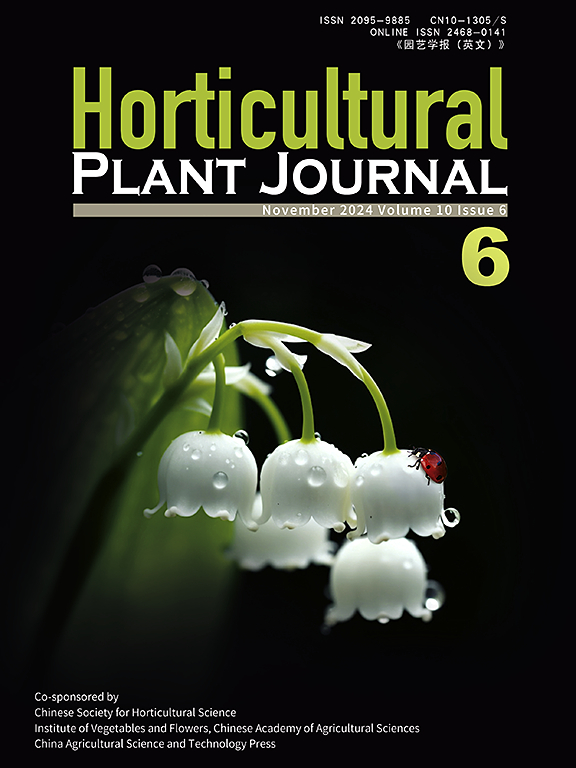依赖于 SlPGR5/SlPGRL1 途径的环状电子传递调节番茄植株的光保护和叶绿体质量
IF 5.7
1区 农林科学
Q1 HORTICULTURE
引用次数: 0
摘要
据报道,质子梯度调节 5(PGR5)依赖的环状电子流(CEF)在水稻和藻类中具有重要的光保护作用。然而,尚未在番茄中对其功能进行评估。在本研究中,我们重点阐明了番茄中和的功能。我们进行了 RNA 干扰,发现-抑制的转化株表现出极低的 CO 同化能力,它们的光系统 I(PSI)和 PSII 受到严重的光抑制,叶绿体明显受损。-抑制的植株几乎完全抑制了 CEF 和 Y(ND),PSII 的光抑制可能与无法产生足够的质子动力诱导 NPQ 直接相关。35S启动子过表达和驱动的转基因植株能够缓解植株在低夜温下的光抑制。转录组和蛋白质组分析表明,核基因转录和叶绿体蛋白(包括质球相关蛋白)的周转与依赖 SlPGR5/SlPGRL1 途径的 CEF 密切相关。据我们所知,CEF与叶绿体质量维持之间的桥梁关系是一个新的报道。总之,这些结果揭示了 SlPGR5/SlPGRL1 途径在番茄光保护和叶绿体功能维持中的调控机制,这对减少产量损失至关重要,尤其是在不利环境条件下。本文章由计算机程序翻译,如有差异,请以英文原文为准。
SlPGR5/SlPGRL1 pathway-dependent cyclic electron transport regulates photoprotection and chloroplast quality in tomato plants
The essential photoprotective role of proton gradient regulation 5 (PGR5)-dependent cyclic electron flow (CEF) has been reported in , rice, and algae. However, its functional assessment has not been performed in tomato yet. In this study, we focused on elucidate the function of and in tomato. We performed RNA interference and found that -suppressed transformants exhibited extremely low CO assimilation capacity, their photosystem I (PSI) and PSII were severely photoinhibited and chloroplasts were obviously damaged. The -suppressed plants almost completely inhibited CEF and Y(ND), and PSII photoinhibition may be directly related to the inability to produce sufficient proton motive force to induce NPQ. The transgenic plants overexpressing and driven by 35S promoter capable alleviate photoinhibition of plants under low night temperature. The transcriptomic and proteomic analyses suggested that the nuclear gene transcription and turnover of chloroplast proteins, including the plastoglobule-related proteins, were closely related to SlPGR5/SlPGRL1 pathway dependent CEF. The bridge relationship between CEF and chloroplast quality maintenance was a novel report to our knowledge. In conclusion, these results revealed the regulatory mechanism of the SlPGR5/SlPGRL1 pathway in photoprotection and maintenance of chloroplast function in tomato, which is crucial for reduce yield loss, especially under adverse environmental conditions.
求助全文
通过发布文献求助,成功后即可免费获取论文全文。
去求助
来源期刊

Horticultural Plant Journal
Environmental Science-Ecology
CiteScore
9.60
自引率
14.00%
发文量
293
审稿时长
33 weeks
期刊介绍:
Horticultural Plant Journal (HPJ) is an OPEN ACCESS international journal. HPJ publishes research related to all horticultural plants, including fruits, vegetables, ornamental plants, tea plants, and medicinal plants, etc. The journal covers all aspects of horticultural crop sciences, including germplasm resources, genetics and breeding, tillage and cultivation, physiology and biochemistry, ecology, genomics, biotechnology, plant protection, postharvest processing, etc. Article types include Original research papers, Reviews, and Short communications.
 求助内容:
求助内容: 应助结果提醒方式:
应助结果提醒方式:


